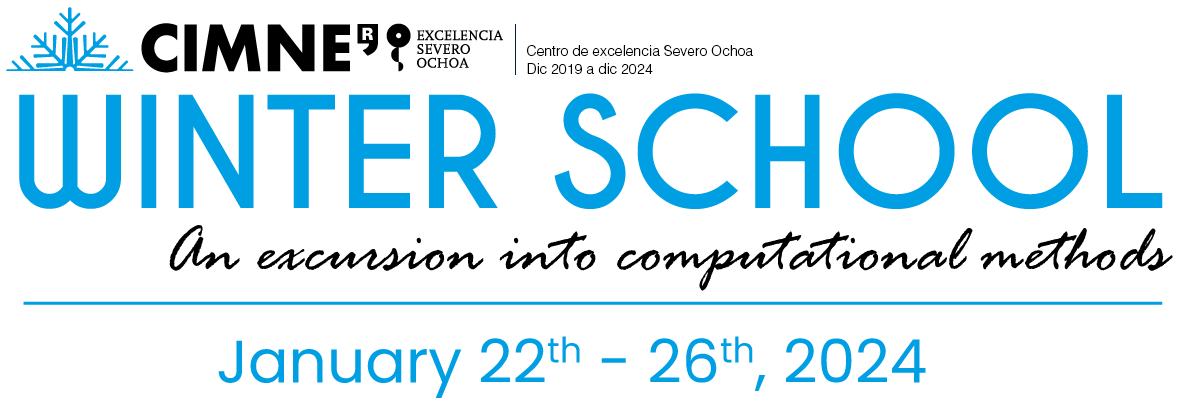
PROGRAMME
| Time | Monday 22 | Tuesday 23 | Wednesday 24 | Thursday 25 | Friday 26 |
| 09:30 - 11:00 | Numerical Lineal Algebra (Theory) by Alba Muixí |
FEM Basics (Theory) by Ignasi de Pouplana |
Continuum Mechanics (Theory) by Oriol Lloberas |
High Performance Computing (Theory) by Riccardo Rossi |
Computational Multiscale (Theory) by Fermin Otero |
| Coffee Break | |||||
| 11:30 - 13:30 | Numerical Lineal Algebra (Practice) by Alba Muixí |
FEM Basics (Practice) by Ignasi de Pouplana |
Continuum Mechanics (Practice) by Oriol Lloberas |
High Performance Computing (Practice) by Riccardo Rossi |
Computational Multiscale (Practice) by Fermin Otero |
| Lunch Break | |||||
| 14:30 - 16:00 | Programming: Good Practice Rules by Sergio Zlotnik |
Oral Communication by Narges Dialami |
Written Comunication by Narges Dialami |
Information search and information resources by Ruth Iñigo |
|
Course Contents
NUMERICAL LINEAL ALGEBRA
Speaker: Alba MuixíDescription: The course reviews methods for solving linear systems of equations, from direct methods based on matrix factorization to iterative approaches. It discusses the solution of overdetermined (and also underdetermined) systems via least-squares criteria, associated with the pseudo-inverse of the matrix and its singular value decomposition. Special attention is paid to difficulties induced by ill-conditioning. It also reviews standard matrix-storage schemes in computational engineering.
PROGRAMMING: GOOD PRACTICE RULES
Speaker: Sergio ZlotnikDescription: Best practices to reduce (at least a bit) the burden of programming: testing, version control, coding style, pair programming... these might smooth out your excursion into computer programs.
FEM BASICS
Speaker: Ignasi de PouplanaDescription: This course aims at giving a brief overview on the Finite Element Method. The first part reviews the Weighted Residual Method (WRM) in the 1D Poisson problem, and the Principle of Virtual Work (PVW) in the 2D solid mechanics problem. The second part is devoted to show the different steps in the solution of a 2D plane stress solid mechanics test example.
Theory (1.5h)
- Introduction to the Finite Element Method
- Weighted Residual Method in the 1D Poisson problem
- Galerkin technique
- Discretization of the weak form
- Shape functions
- Global assembly and solution of the linear system of equations
- Principle of Virtual Work in the 2D solid mechanics static problem
- Equivalence with the WRM
- Elementary contributions
- Numerical integration
- Step by step solution of a Three-point bending test example (linear elastic plane stress hypothesis)
- Installation of the necessary software
- Preparation and resolution of the example
ORAL COMMUNICATION
Speaker: Narges DialamiDescription:This course develops students’ abilities to communicate science effectively in the real world starting with the key elements of clear and persuasive speaking, writing and exhibiting. The objective of the module is to help the students identify the important aspects of the preparation of scientific works, while improving their oral and written communication skills. In this first session the course will focus on oral communication skills.
WRITTEN COMMUNICATION
Speaker: Narges DialamiDescription:This course develops students’ abilities to communicate science effectively in the real world starting with the key elements of clear and persuasive speaking, writing and exhibiting. The objective of the module is to help the students identify the important aspects of the preparation of scientific works, while improving their oral and written communication skills. In this first session the course will focus on written skills.
CONTINUUM MECHANICS
Speaker: Oriol LloberasDescription: Continuum mechanics is an essential discipline for the understanding of motion, deformation and constitutive behaviour of any continuous medium. It transversally impacts many engineering fields such as solid and fluid mechanics. Within this course the basic knowledge on the description of motion and deformation are outlined together with the concept of stress. Balance principles valid for any continuous media will be enunciated and some basic notions on elastic solids and their governing equations will be introduced. A simple practical case will be explored in which the Navier equations will be employed to fully solve a linear elastic problem.
HIGH PERFORMANCE COMPUTING
Speaker: Riccardo RossiDescription: The goal of this brief course is to provide a general overview about the methods and programming environment which allow exploiting the use of supercomputers or even simply the internal parallelism of CPUs. The course will provide a hint of loop-level parallelization models, of task-based models which allow addressing complex concurrency problems, and of the MPI paradigm. A hint of other parallelization models will also be provided.
INFORMATION SEARCH AND INFORMATION RESOURCES
Speaker: Ruth IñigoDescription: During this session we will talk about how to structure your information search strategy and how to find relevant bibliography for both your research plan and your thesis, using the main sources of information such as Google Scholar, Web of Science or Scopus databases. We will also look at generative AI tools applied to information search and selection, and make some considerations about their use in academic contexts.
COMPUTATIONAL MULTISCALE
Speaker: Fermin OteroDescription: Multiscale analysis is a fundamental approach in various scientific and engineering disciplines that aims to understand complex systems by examining their behavior and properties across multiple levels of scale. Multiscale theory is base on the separation of scales, which refers to the idea that different phenomena or processes occur at different levels of detail or "scales" within a system. This brief course provides a comprehensive introduction to the principles, techniques, and applications of multiscale analysis. In addition, the Representative Volume Element (RVE) concept will be introduced together with the different admissible boundary conditions. As an example of application, a multiscale analysis for the study of heterogeneous materials such as composites with complex microstructures will be explained in detail.




